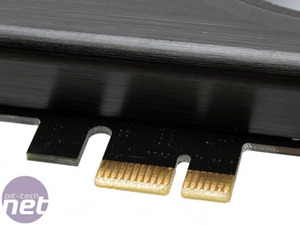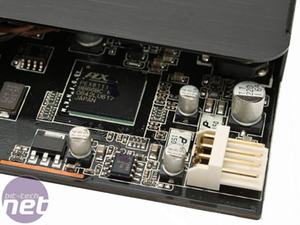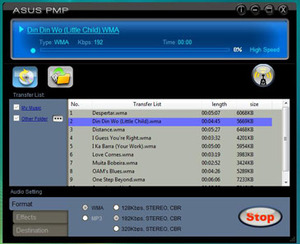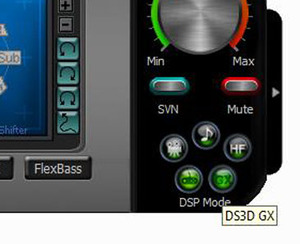ALT provides a legal loophole for obtaining DRM-free audio. Basically, once the digital audio has been decoded and is passed into the analogue hardware it’s now free of any restrictions. The ALT hardware then re-records this audio back into digital form but without the digital restrictions in place, giving near-perfect replication.
Asus freely advertises its product as a legal way to get around DRM because technically you’re not cracking anything – you’re simply playing it then recording it again. It’s not an invitation for piracy though, this is clearly stated to empower the end user by allowing them to backup or convert their music into any format they wish.
The ALT feature is available thanks to the Asus Portable Media Processor (PMP) which also allows you to add ‘effects’ like Dolby Headphone or Dolby Virtual Speaker to the converted files. The downside to this when we first looked at the software was that it was incredibly limited and slow compared to CPU file transcoding as it had to play back the files at a 1:1 rate – so a full hour of DRM music will take an hour to backup.
We threw the Xonar D2X (read: gently inserted – Ed) into a variety of PCI-Express slots – it doesn’t matter what length slot you use, be it x1 or x16, the interface will automatically adapt itself to work with it. We tried the card in several systems using x1, x4, x8 and x16 slots, both PCI-Express 1.1 and 2.0, and it worked flawlessly in all of them. The bigger problem though was finding a power supply with a spare floppy connector.
We may review a fair number PSUs, but most models don’t feature a connector of that type nowadays – and rightly so considering the last time I used a floppy connector was with an ATI Radeon 9800 Pro. A Molex would have been a far better choice for Asus as it is more popular and there'd be plenty of connectors to choose from. With this method you may find yourself re-routing all your PSU cables to free up your lone floppy connector.
New to the board is a PLX Technology PEX 8111 chip that converts the Asus AV200 PCI interface into the PCI-Express x1 connection the card uses. It’s a simple bridge chip, but Asus has still had to re-engineer the drivers because it adds latency to the connection – we heard Creative were in a similar position too, but decided to change the core silicon for the non-hardware accelerated models instead. An educated guess is that the bridge chip is also partly the reason why the card needs an additional power source, because the core hardware is geared to the 5V PCI interface.
The improved Vista gaming compatibility comes from Asus’ DS3D GX which is designed to convert DirectSound and EAX (up to 2.0) to work in the new OpenAL sound model in Vista. It’s just like Creative’s Alchemy solution, except this is free and it’s designed to work with everything.
The core software included is identical to the PCI version, giving the same Hi-Fi-esque interface that’s all looks and no ease of use. The buttons are fiddly, hard to see and the settings are sometimes confusing. The Asus PMP software also has the same very limited features as before – the conversion is limited to either .WMA or .MP3 at 128, 192 or 320kbps and no .MP3 encoder is even supplied (so that Asus gets around paying for a licence) so you have to download one separately.
The ALT is entirely contained within this software so there's currently no way of using it as a plug-in elsewhere. The only update this has received since we last looked at it is that it now works at a much higher speed, taking seconds instead of minutes to complete a track, but to say the whole thing is still disappointing feels like a understatement.
We tried Cyberlink PowerDVD 7.0 to check if there were any Asus specific features; however, on installing the software it asked for a CD key for activation. Fair enough, but there was no key provided! We searched but found nothing on the CD, the paper sleeve, in the box or even in the manual. We tried to contact Asus about this problem, confident we must have overlooked or lost something, but the company’s representatives were unavailable for comment at the time.
Asus freely advertises its product as a legal way to get around DRM because technically you’re not cracking anything – you’re simply playing it then recording it again. It’s not an invitation for piracy though, this is clearly stated to empower the end user by allowing them to backup or convert their music into any format they wish.
The ALT feature is available thanks to the Asus Portable Media Processor (PMP) which also allows you to add ‘effects’ like Dolby Headphone or Dolby Virtual Speaker to the converted files. The downside to this when we first looked at the software was that it was incredibly limited and slow compared to CPU file transcoding as it had to play back the files at a 1:1 rate – so a full hour of DRM music will take an hour to backup.
We threw the Xonar D2X (read: gently inserted – Ed) into a variety of PCI-Express slots – it doesn’t matter what length slot you use, be it x1 or x16, the interface will automatically adapt itself to work with it. We tried the card in several systems using x1, x4, x8 and x16 slots, both PCI-Express 1.1 and 2.0, and it worked flawlessly in all of them. The bigger problem though was finding a power supply with a spare floppy connector.
We may review a fair number PSUs, but most models don’t feature a connector of that type nowadays – and rightly so considering the last time I used a floppy connector was with an ATI Radeon 9800 Pro. A Molex would have been a far better choice for Asus as it is more popular and there'd be plenty of connectors to choose from. With this method you may find yourself re-routing all your PSU cables to free up your lone floppy connector.
New to the board is a PLX Technology PEX 8111 chip that converts the Asus AV200 PCI interface into the PCI-Express x1 connection the card uses. It’s a simple bridge chip, but Asus has still had to re-engineer the drivers because it adds latency to the connection – we heard Creative were in a similar position too, but decided to change the core silicon for the non-hardware accelerated models instead. An educated guess is that the bridge chip is also partly the reason why the card needs an additional power source, because the core hardware is geared to the 5V PCI interface.
The improved Vista gaming compatibility comes from Asus’ DS3D GX which is designed to convert DirectSound and EAX (up to 2.0) to work in the new OpenAL sound model in Vista. It’s just like Creative’s Alchemy solution, except this is free and it’s designed to work with everything.
The core software included is identical to the PCI version, giving the same Hi-Fi-esque interface that’s all looks and no ease of use. The buttons are fiddly, hard to see and the settings are sometimes confusing. The Asus PMP software also has the same very limited features as before – the conversion is limited to either .WMA or .MP3 at 128, 192 or 320kbps and no .MP3 encoder is even supplied (so that Asus gets around paying for a licence) so you have to download one separately.
The ALT is entirely contained within this software so there's currently no way of using it as a plug-in elsewhere. The only update this has received since we last looked at it is that it now works at a much higher speed, taking seconds instead of minutes to complete a track, but to say the whole thing is still disappointing feels like a understatement.
We tried Cyberlink PowerDVD 7.0 to check if there were any Asus specific features; however, on installing the software it asked for a CD key for activation. Fair enough, but there was no key provided! We searched but found nothing on the CD, the paper sleeve, in the box or even in the manual. We tried to contact Asus about this problem, confident we must have overlooked or lost something, but the company’s representatives were unavailable for comment at the time.

MSI MPG Velox 100R Chassis Review
October 14 2021 | 15:04













Want to comment? Please log in.